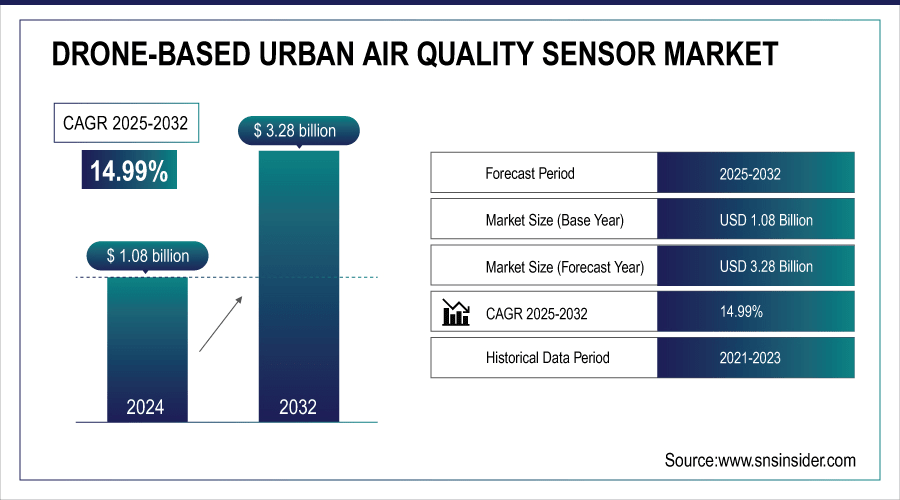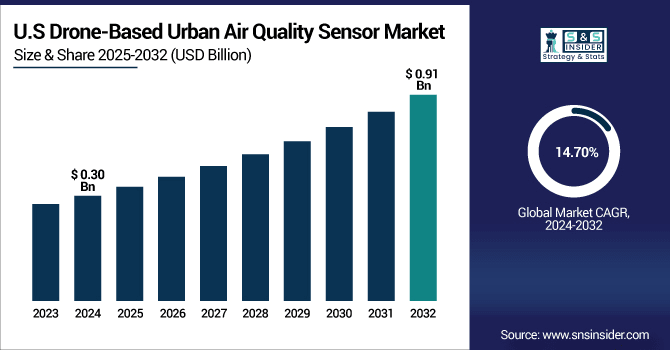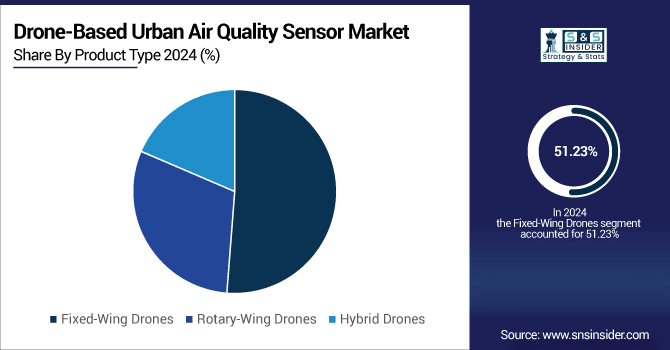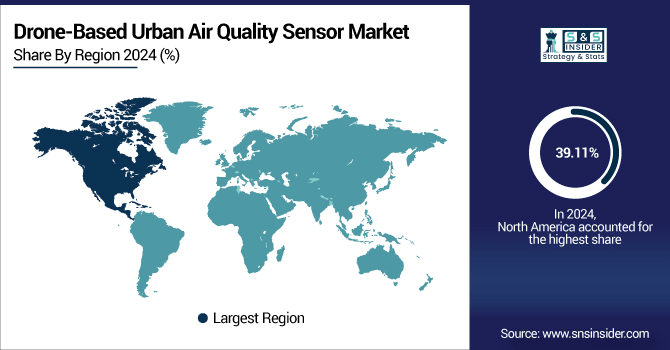Drone-Based Urban Air Quality Sensor Market Report Scope & Overview:
The Drone-Based Urban Air Quality Sensor Market size was valued at USD 1.08 Billion in 2024 and is projected to reach USD 3.28 Billion by 2032, growing at a CAGR of 14.99% during 2025-2032.
The Drone-Based Urban Air Quality Sensor Market is expanding due to the increasing concern of air pollution in crowded cities and demands for real-time monitoring. Drones with the right sensors would be able to collect data quickly, cheaply and in more locations than ground-based stations. Increasing usage in study of environments, smart city projects, and consumer compliance will boost the market.
Over 45% of smart city initiatives in major urban centers—including Beijing, Delhi, Los Angeles, and Singapore—are now integrating drone-based environmental monitoring systems for real-time air quality assessment.

To Get More Information On Drone-Based Urban Air Quality Sensor Market - Request Free Sample Report
Drone-Based Urban Air Quality Sensor Market Trends
-
Growth of city pollution and associated health issues adding to demand for monitoring solutions.
-
Drones offer a mobile yet cheaper alternative to land-based monitoring stations.
-
Quick adoption backed up by Smart City projects, infrastructure and interoperability.
-
Governments, academia, and startups are collaborating to drive research and application development of drone-based systems.
-
When AIoT is integrated, real-time and precise prediction and analysis of air quality trends are possible.
The U.S. Drone-Based Urban Air Quality Sensor Market size was valued at USD 0.30 Billion in 2024 and is projected to reach USD 0.91 Billion by 2032, growing at a CAGR of 14.70% during 2025-2032. Drone-Based Urban Air Quality Sensor Market growth is driven by growing awareness about the effects of air pollution on public health and environmental sustainability. New technologies to monitor stepwise caused by government and Initiatives step, due to air more cleaner relaxing. State-of-the-art sensors mounted on drones provide high-resolution real-time air quality data over urban areas. Growing demand from applications of construction, transportation, and energy will also promote the adoption for compliance and safety monitoring.

The Drone-Based Urban Air Quality Sensor Market trends include the partnerships between private firms, research institutions, and government agencies are driving market growth. Taken together these two are setting the U.S. in the role of a global leader for the fusing of drones with air quality monitoring.
Drone-Based Urban Air Quality Sensor Market Growth Drivers:
-
Rising Urban Pollution Levels and Demand for Real-Time Air Quality Monitoring Using Drone-Based Sensors.
The market is fuelled by rising city air pollution and its toll on public health. Drones' dynamic, cost-effective way of monitoring compared to static terrestrial stations. Adaptation is fast paced due to its interoperability with smart city initiatives. Increasing regulation around environmental compliance also drives demand. Increasing scrutiny of environmental regulation also provides a lift.
Drone-based air quality monitoring is 50–70% cheaper per square kilometer surveyed than deploying and maintaining fixed ground stations. A single drone can collect high-resolution data across 50+ locations in under 2 hours, compared to days for manual or static methods.
Drone-Based Urban Air Quality Sensor Market Restraints:
-
High Operational Costs and Regulatory Challenges Limiting Large-Scale Drone-Based Air Quality Sensor Deployments
Small organizations find it financially prohibitive to deploy advanced sensors and fly drones. Stringent aviation and safety rules have put a damper on large-scale urban deployments. Trust in UAV-based solutions is compromised by data accuracy and calibration issues. Privacy and safety concerns continue to remain a significant hurdle. Privacy and security of the public are still essential challenges.
Drone-Based Urban Air Quality Sensor Market Opportunities:
-
Advancements in Sensor Miniaturization and AI-Enabled Data Analytics Transforming Drone-Based Air Quality Monitoring
Increasing investment in smart city projects is further anticipated to support the demand for drone based surveillance systems. Partnerships between governments, universities and start-ups are encouraging innovation and deployment. Collectively, these trends are likely to create growth opportunities for the drone-based urban air quality sensor market. AIoT enables predictive analytics for precise prediction of air quality.
In 2024, over 70% of new drone-based air quality systems are integrated with AIoT platforms, combining real-time sensor data with machine learning models to forecast pollution levels up to 72 hours in advance with over 88% accuracy.
Drone-Based Urban Air Quality Sensor Market Segment Analysis
-
By Product type, Fixed-Wing Drones led the market with around 51.23% share, while Rotary-Wing Drones emerged as the fastest-growing segment with a CAGR of 15.68%.
-
By Sensor type, Gas Sensors dominated with about 45.62% share, whereas Particulate Matter Sensors recorded the fastest growth with a CAGR of 15.83%.
-
By Application, Air Pollution Monitoring accounted for nearly 35.22% share, while Emission Source Detection was the fastest-growing segment with a CAGR of 15.94%.
-
By End-user, Government & Municipalities held the largest share at approximately 48.31%, while Environmental Agencies showed the fastest growth with a CAGR of 15.53%.
By Product Type, Fixed-Wing Drones Leads Market While Rotary-Wing Drones Registers Fastest Growth
In terms of product type, fixed-wing drones are used the most in the drone-based urban air quality sensor market as they provide longer flight time and can capture video footages from vast city areas, and thus find application in projects that involve large-scale environmental monitoring and pollution evaluation. On the other hand, rotary-wing drones are growing the most rapidly because of their nimbleness and ease of use, being able to hover and fly in close quarters around dense urban environments they seem best suited for localized air quality monitoring.

By Sensor Type, Gas Sensors Dominate While Particulate Matter Sensors Shows Rapid Growth
Based on the sensor type, the drone-based urban air quality sensor market is led by the gas sensors segment, as they are massively adopted for the detection of harmful gases and for monitoring the quality of the air. Such sensors are absolutely needed for constant environmental monitoring monitoring and regulatory needs. Particulate matter (PM) sensors, in contrast, are being adopted quickly as they offer accurate measures of fine particles that affect human health. They are being increasingly adopted in urban and industrial regions for pollution hotspot identification.
By Application, Air Pollution Monitoring Lead While Emission Source Detection Registers Fastest Growth
Based on application, air pollution monitoring dominates the market for drone-based urban air quality sensor since it is the foremost concern areas for cities and regulatory bodies to monitor the quality of the environment. These programs are assisting in the identification of pollution trends and in protecting public health. By type, emission source detection is projected to grow at the highest rate owing to escalating demand for identification of industrial and vehicular pollution sources.
By End-User, Government & Municipalities Lead While Environmental Agencies Grow Fastest
Based on end-user, the government and municipalities segment is dominating the drone-based urban air quality sensor market as they are the main end-users for controlling and maintaining the urban air quality. These organizations use drones to enforce regulations and protect public health. Meanwhile, environmental organisations are seeing the fastest growth on the back of growing demand for research, policy formulation and local pollution inspection.
Drone-Based Urban Air Quality Sensor Market Regional Analysis
North America Drone-Based Urban Air Quality Sensor Market Insights
In 2024 North America dominated the Drone-Based Urban Air Quality Sensor Market and accounted for 39.11% of revenue share, this leadership is due to the region’s extensive monitoring and its stringent air quality rules. Widespread use of advanced drone technologies and sensors enables real-time monitoring of pollution throughout the city landscape. Smart cities and Financing by the government to promote smart city projects also serve as market drivers. Private sector-research institutions partnerships also help in technology transfer and its application in the area.

Get Customized Report as Per Your Business Requirement - Enquiry Now
U.S. Drone-Based Urban Air Quality Sensor Market Insights
The U.S. urban air quality sensor market for drones is growing on account of rising levels of air pollution and rising public concern towards the same. Cutting-edge drones fitted with gas and particle sensors deliver hyper-local, on-demand, high-resolution mapping to city and regulatory authorities. General Policies and smart city projects are facilitating the wide spread of such technologies.
Asia-pacific Drone-Based Urban Air Quality Sensor Market Insights
Asia-pacific is expected to witness the fastest growth in the Drone-Based Urban Air Quality Sensor Market over 2025-2032, with a projected CAGR of 15.66% due to manufacturing and industrial sectors which is driving increased demand for real-time air quality information in the region. Aerial and sensing technology plays a crucial role in this, contributing to cost-effective monitoring. Government backing and partnerships with private industry and research institute are also boosting market growth in the region.
China Drone-Based Urban Air Quality Sensor Market Insights
The China drone-based urban air quality sensor market has been growing quickly in response to increasing urban pollution and government attention to monitoring and improving air quality. Smart drones equipped with gas and particulate matter sensors have been used in cities to monitor the environment in real time.
Europe Drone-Based Urban Air Quality Sensor Market Insights
In 2024, Europe emerged as a promising region in the Drone-Based Urban Air Quality Sensor Market, due to new advanced drones equipped with gas and particulate matter sensors for real-time air quality monitoring. Rising investments in smart city projects and sustainable urban planning are fuelling market growth. Rapid development in UAV platforms and sensors enable better monitoring performance and accuracy.
Germany Drone-Based Urban Air Quality Sensor Market Insights
The Germany drone-based urban air quality sensor market in Germany is witnessing a moderate growth due to the strict environmental regulations and growing attention towards sustainable urban development. More advanced drones that have gas and particulate matter sensors are commonly used for real-time tracking of air quality in cities and industrial sites.
Latin America (LATAM) and Middle East & Africa (MEA) Drone-Based Urban Air Quality Sensor Market Insights
The Drone-Based Urban Air Quality Sensor Market is experiencing moderate growth in the Latin America (LATAM) and Middle East & Africa (MEA) regions, due to the rising air pollution levels and the implementation of real-time monitoring solutions. Rising adoption in urban and industrial sectors is boosting the market for drones and sensors with higher capabilities. Moreover, the introduction of smart city projects and environmental programs is boosting the market growth. Better sensor accuracy and drone reliability make technology approaches work better.
Drone-Based Urban Air Quality Sensor Market Competitive Landscape
DJI Innovations is a global drone-based urban air quality sensor market leader, renowned for its high-end drone platforms and integration of sensors. Its drones can do real-time monitoring of air quality and have guaranteed high precision and accuracy. It technologies are used by government, environmental organizations and industry globally.
-
In July 2024, DJI launched the Matrice 3D Air Quality Edition, a purpose-built variant of its M3D drone, integrated with a multi-gas sensing payload developed in collaboration with Aeroqual.
Parrot SA is one of the key players in the urban air quality sensor drones market providing state-of-art drows integrated with high precision gas and particulate matter sensors. The firm specializes in creating easy-to-use platforms for urban and industrial monitoring. Its drones are commonly used by research institutions, environmental agencies and municipalities. The adoption of sensor tech and the flight features keep improving along the way for better performance and reliability.
-
In June 2024, Parrot SA launched the ANAFI AI Thermal + Air Monitor Edition, a new configuration of its AI-powered drone equipped with an integrated multi-sensor payload for real-time detection of PM1, PM2.5, PM10, CO₂, NO₂, and VOCs.
AeroVironment Inc AeroVironment Inc.is among the major players in the urban drone-based air quality sensor market and is known for its multi-rotor drones designed for environmental sensing. The firm offers drones that can take high-fidelity air quality data in urban and industrial environments. Government bodies, research agencies and environmental monitoring companies are among those that tap into its services.
-
In July 2024, AeroVironment launched the Quantum-300 Series, an upgraded version of its SUAS (Small Unmanned Aircraft System) platform, now integrated with ultra-compact multi-gas sensors for real-time monitoring of CO, NO₂, O₃, SO₂, and PM2.5.
PrecisionHawk is a leading contributor to the urban air quality sensor market through its drone-based offerings and data analytics services. The startup aims to provide real-time air quality tracking with its ultra-precise sensors and AI-backed analytics. Its clients include environmental agencies, towns and private companies. Dedicated R&D spending enables PrecisionHawk to improve sensor accuracy, flight performance and mission efficiency.
-
In August 2024, PrecisionHawk launched LIDAR+AQ v2.0, an integrated drone payload combining high-resolution gas sensing (for NO₂, O₃, CO, and PM2.5) with multispectral imaging and LiDAR, enabling 3D mapping of air pollution dispersion in urban environments.
Drone-Based Urban Air Quality Sensor Companies are:
-
Parrot SA
-
AeroVironment Inc.
-
PrecisionHawk
-
senseFly (Parrot Group)
-
Yuneec International
-
Flyability
-
AirSense Analytics
-
Microdrones GmbH
-
Atmos UAV
-
Draganfly Innovations Inc.
-
Aeroqual
-
Clarity Movement Co.
-
ENVEA (formerly Environnement S.A)
-
Aeromon
-
UAVONIC
-
Skyfront
-
Percepto
-
Honeywell International Inc.
| Report Attributes | Details |
|---|---|
| Market Size in 2024 | USD 1.08 Billion |
| Market Size by 2032 | USD 3.28 Billion |
| CAGR | CAGR of 14.99% From 2025 to 2032 |
| Base Year | 2024 |
| Forecast Period | 2025-2032 |
| Historical Data | 2021-2023 |
| Report Scope & Coverage | Market Size, Segments Analysis, Competitive Landscape, Regional Analysis, DROC & SWOT Analysis, Forecast Outlook |
| Key Segments | • By Product Type (Fixed-Wing Drones, Rotary-Wing Drones, Hybrid Drones) • By Sensor Type (Gas Sensors, Particulate Matter Sensors, Multi-Sensor Systems, Others) • By Application (Air Pollution Monitoring, Emission Source Detection, Industrial Monitoring, Research & Academic, Others) • By End-User (Government & Municipalities, Environmental Agencies, Industrial, Research Institutes, Others |
| Regional Analysis/Coverage | North America (US, Canada), Europe (Germany, UK, France, Italy, Spain, Russia, Poland, Rest of Europe), Asia Pacific (China, India, Japan, South Korea, Australia, ASEAN Countries, Rest of Asia Pacific), Middle East & Africa (UAE, Saudi Arabia, Qatar, South Africa, Rest of Middle East & Africa), Latin America (Brazil, Argentina, Mexico, Colombia, Rest of Latin America). |
| Company Profiles | DJI Innovations, Parrot SA, AeroVironment Inc., PrecisionHawk, Delair, senseFly (Parrot Group), Yuneec International, Flyability, AirSense Analytics, Microdrones GmbH, Atmos UAV, Draganfly Innovations Inc., Aeroqual, Clarity Movement Co., ENVEA (formerly Environnement S.A), Aeromon, UAVONIC, Skyfront, Percepto, Honeywell International Inc. |

